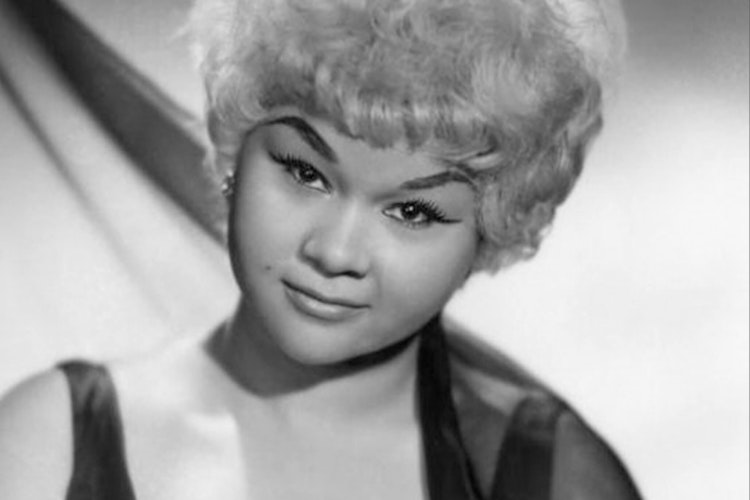In this article, we acknowledge 11 influential and significant Black artists and figures in Rock and Popular music who started their music careers from the late 1940s through the mid-50s. We begin with Little Richard and take you up to Aretha Franklin.
Don’t forget to review all of our other artist lists.
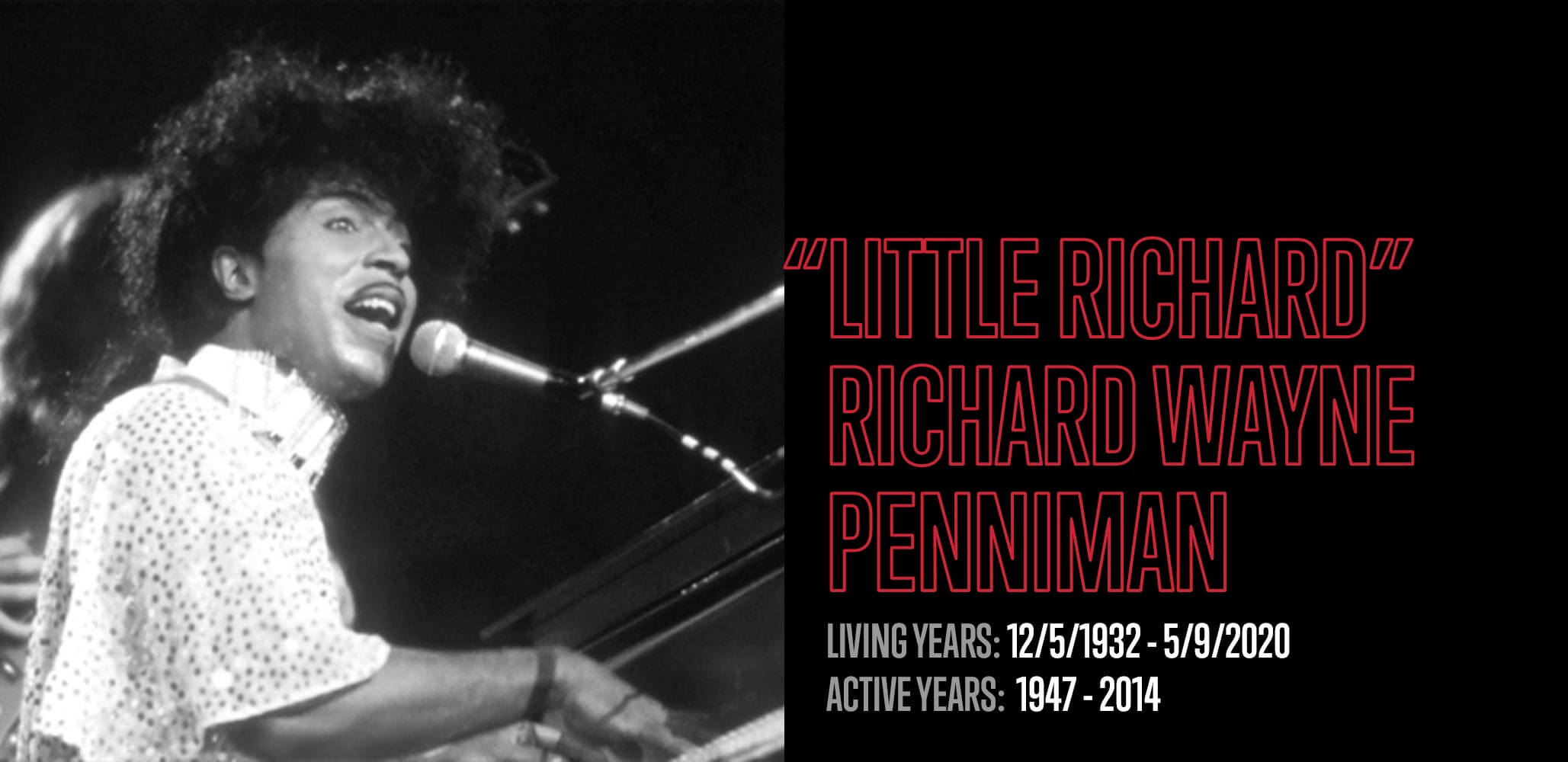
Instruments
Vocals, piano
Genres
Rock and Roll, Gospel
Notable Songs
Tutti Frutti, Good Golly Miss Molly, Rip It Up, Long Tall Sally
Biography
Richard Wayne Penniman, known the world over as Little Richard, was born in Macon, Georgia in 1932. Inspired by Gospel performers including Sister Rosetta Tharpe, Richard went from singing hymns to performing in minstrel shows and traveling carnivals. Influenced by a flamboyant entertainer named Esquerita, Richard’s showmanship, powerful voice and pounding piano style earned him the nickname the “Architect of Rock and Roll.”
Richard was signed to his first recording contract with RCA in 1950 but the recordings failed to attract any attention outside of Georgia. Another contract followed with Houston’s Peacock Records and Richard finally had his first hit on Specialty Records with “Tutti Frutti” in 1955. Recorded in New Orleans at Cosimo Matassa’s J and M Studio, “Tutti Frutti” established Richard as an original voice and one of Rock and Roll’s wildest performers. He had several other hits during this period including “Long Tall Sally”, “Rip it Up”, and “Good Golly Miss Molly”.
In 1958, Richard decided that he was no longer going to record secular music and he returned to Gospel music. Richard’s struggle with reconciling his musical identity as well as his sexual identity was a constant theme in his career. He returned to playing Rock and Roll just a few years later, touring in Europe where his opening bands included the Beatles and the Rolling Stones. Paul McCartney's vocal style was hugely influenced by Richard. Richard also gave a young Jimi Hendrix a gig as lead guitarist before Jimi embarked on his own solo career. Hendrix was obviously influenced by his former boss, taking cues on showmanship from Richard.
In the 70’s, Richard continued to tour and release music but he was mostly relegated to the “oldies” circuit. He continued to have a presence on TV and in film but he retired from music again in 1976. In 1984 he staged a comeback, releasing an autobiography and returning to the public eye. He kept a busy schedule but was increasingly hampered by health problems. In 2010 Richard announced he would be retiring and played his final concert in 2014. Little Richard passed away May 9, 2020. He was 87.
Artists/Acts They Influenced
Prince, The Beatles, Otis Redding, Jimi Hendrix, Elton John, James Brown, Michael Jackson
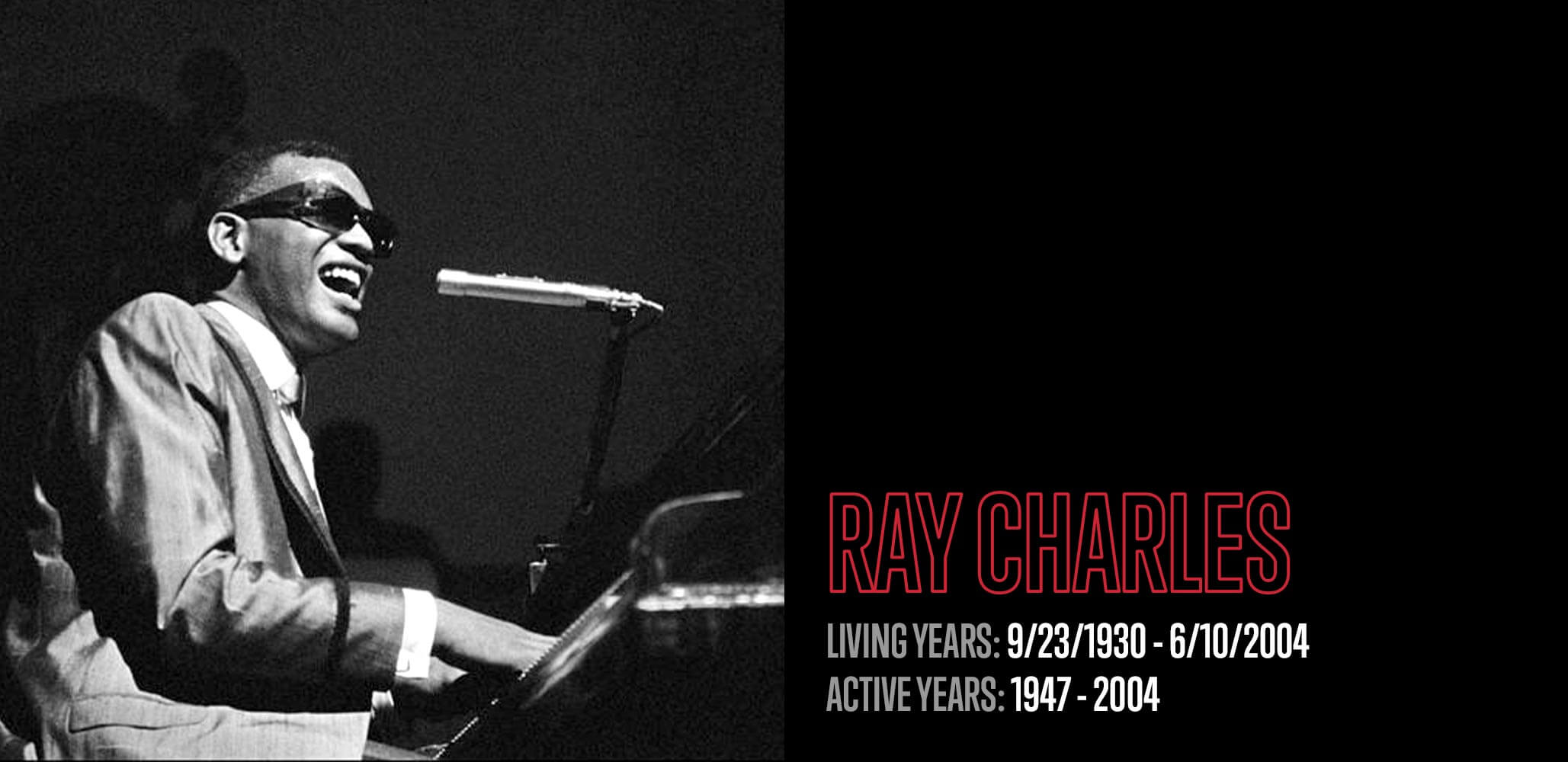
Instruments
Vocals, piano, trumpet, sax, clarinet, organ
Genres
Soul, Blues, Gospel, R&B, Jazz, Swing, Boogie Woogie, Country-Western
Notable Songs
Hit the Road Jack, Georgia On My Mind, What’d I Say, I Got a Woman, Drown In My Own Tears
Biography
One of the greatest visionaries of Soul and R&B music, Ray Charles Robinson was born in Albany, Georgia, and raised in a poor family in Greenville, Florida. Growing up, Ray’s local community was filled with the sounds of Blues, Jazz, Gospel, Boogie-Woogie and Country music. He spent much of his time at the Red Wing Café, which had a jukebox. Ray passed many hours listening to Blues and Big Band music on the jukebox. The owner, Wylie Pitman, taught him how to play piano, first short melodies, then the Blues and Boogie-Woogie. He was also inspired by artists like Art Tatum, Duke Ellington, Count Basie, Nat King Cole, Charles Brown, Benny Goodman and clarinetist Artie Shaw.
At age 5, Ray’s eyesight began to blur soon after witnessing the traumatic drowning of his younger brother George. The slow, gradual loss of Ray’s eyesight due to glaucoma allowed his mother to work diligently to teach Ray to become independent and to learn ways to offset his lack of sight.
The year 1954 was a big turning point for Ray. He recorded a Gospel tune with rewritten lyrics. The song was called “I Got a Woman”. The style of this song was the blueprint to which the “Soul Music” genre was formed. It was a global hit that brought Ray Charles to the limelight.
Ray had major success in the R&B, Blues and Jazz genres. In 1960, he popularized the country song “Georgia on My Mind” originally written by Stuart Gorrell & Hoagy Carmichael in 1930. The song became closely associated with him for the rest of his career and the state of Georgia eventually adopted Ray’s version as its state song in 1979. In 1962, Ray’s pair of Modern Sounds in Country and Western Music albums had a large impact in racially integrating Pop and Country music. During this time, he was an advocate for civil rights, frequently refusing to perform for segregated audiences and vocally supporting Dr. Martin Luther King, Jr.
As Rock, Funk, and Disco gained popularity in the 1970s, Ray Charles’ career stagnated. Though he continued to release albums and was widely respected throughout the music industry, he never commercially recaptured the success of his days as an early Soul and Rock pioneer. Ray participated in the “We Are the World” recording session in 1985 and the next year Quincy Jones inducted Ray Charles into the Rock and Roll Hall of Fame. Ray made periodic appearances throughout the 90s and early 2000s, though his health began to decline. He died of liver failure in 2004.
Historical or Cultural Context
Bridged the gap between Gospel and Secular music to help create Soul Music. Crossed over and released Country and Western music albums.
Artists/Acts They Influenced
Mick Jagger, Joe Cocker, Rod Stewart, Nina Simone, Dizzy Gillespie, Charlie Parker, John Coltrane, Elvis Presley, Steve Winwood, Billy Joel, Quincy Jones; background vocals of the Shirelles, the Supremes, Martha and the Vandellas
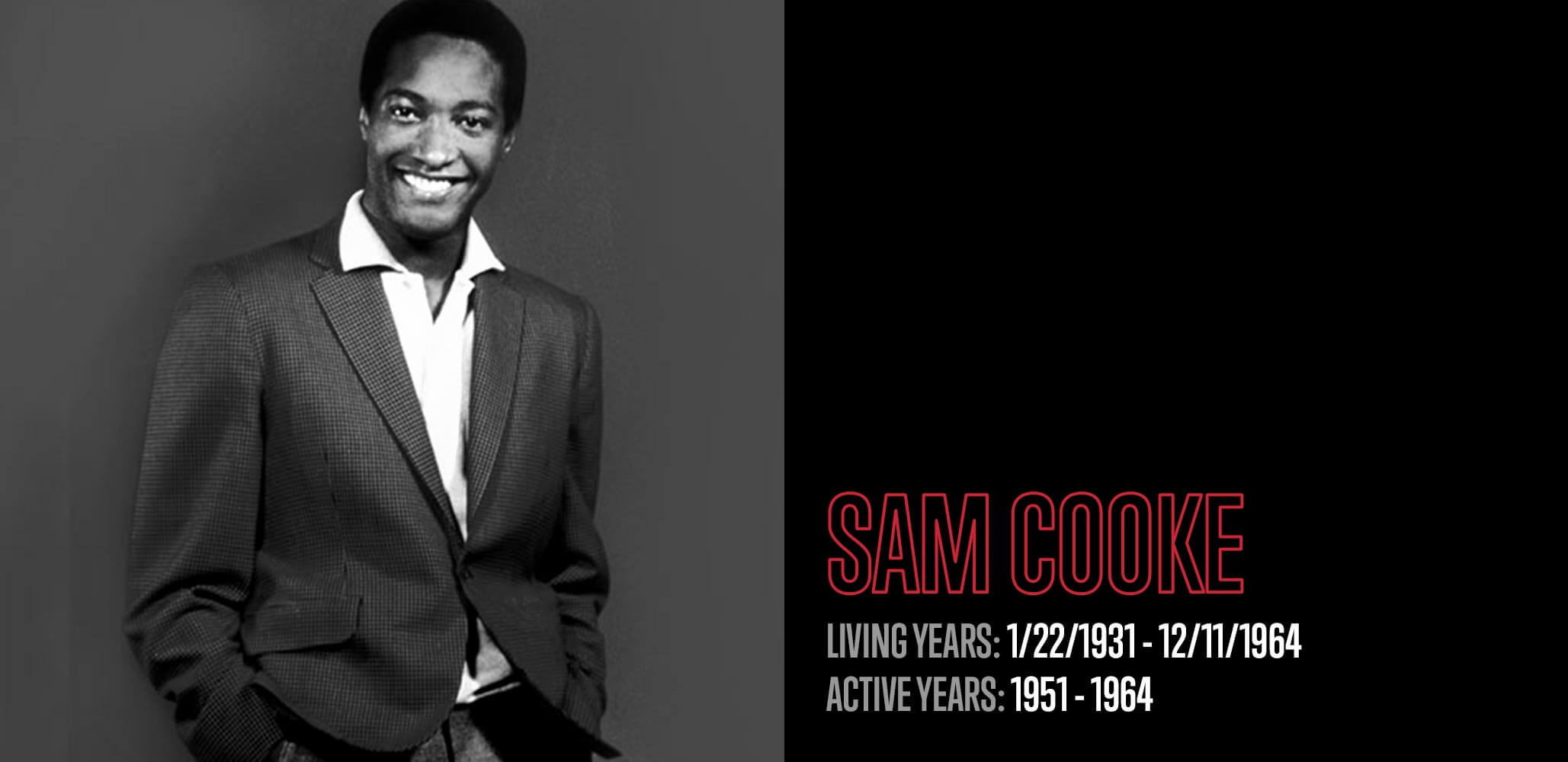
Instruments
Vocals, piano, guitar
Genres
Soul, R&B, Gospel
Notable Songs
A Change is Gonna Come, Bring It On Home to Me, Twistin’ the Night Away
Associated Artists/Acts
Otis Redding, Lou Rawls, Bobby Womack
Biography
Sam Cooke is widely regarded as one of the greatest singers in popular music history and was a pioneer in the development of the genre of Soul music. Cooke grew up the son of a minister in Clarksdale, Mississippi and began singing as a small child. By his teens, he was a successful Gospel singer leading The Highway QC’s and The Soul Stirrers, two of Gospel’s most legendary groups.
In 1956, Cooke made the decision to branch out into popular music and quickly found massive success. In the eight years that followed, Cooke had an amazing 29 songs reach the Billboard Top 40. His smooth, expressive tenor influenced countless artists who followed him, but Cooke was also inspirational to his contemporaries as a performer who wrote most of his own songs and as a businessman who ran his own record label and publishing company. Cooke wrote many songs that have become R&B classics such as “Bring It On Home to Me”, “Twistin’ the Night Away”, “Wonderful World”, “You Send Me” and “Cupid”. However, he is perhaps best known for writing and recording “A Change Is Gonna Come”, which when released in 1964, two weeks after Cooke’s untimely death at age 33, became an anthem for the Civil Rights Movement. The song’s message still reverberates strongly today: it was performed at the inauguration of President Barack Obama in 2008, and the lyrics adorn the wall of the Contemplative Court inside the Smithsonian’s National Museum of African American History and Culture.
Sam Cooke’s legacy as The King of Soul is unquestioned and he influenced many of R&B’s superstars including Otis Redding, Stevie Wonder and Marvin Gaye. He was inducted into the Rock and Roll Hall of Fame in 1986, its inaugural year, fittingly making him a charter member of the institution. Cooke was also a civil rights activist, refusing to perform to segregated audiences and using his celebrity to support other activists like Martin Luther King, Jr. and Muhammad Ali.
Historical or Cultural Context
King of Soul Music, crossed over from Gospel to Secular music, civil rights activist
Artists/Acts He Influenced
Otis Redding, Stevie Wonder, Marvin Gaye, Al Green, Rod Stewart
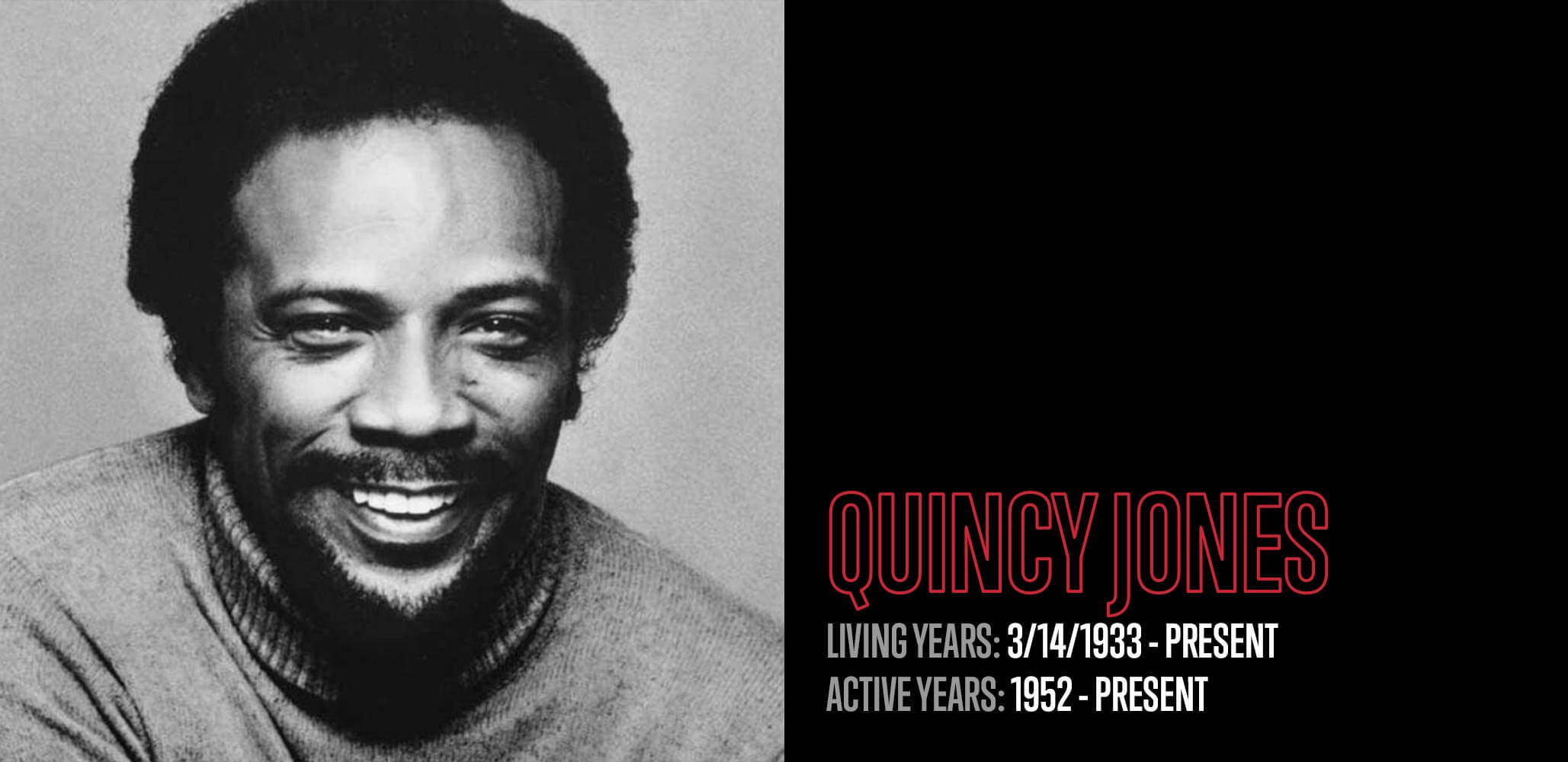
Genres
Jazz, Pop, Rock, Bossa Nova
Notable Songs
Soul Bossa Nova, It’s My Party, You Don’t Own Me, P.Y.T., We Are the World
Associated Artists/Acts
Lionel Hampton, Sarah Vaughan, Dinah Washington, Count Basie, Duke Ellington, Gene Krupa, Ray Charles, Tommy Dorsey, Elvis Presley, Dizzy Gillespie, Ella Fitzgerald, Frank Sinatra, Sammy Davis Jr., Dean Martin, Diana Ross, Michael Jackson, Will Smith, Miles Davis, Celine Dion, Harry Connick Jr., Chaka Khan, Marvin Gaye, Amy Winehouse
Biography
Quincy Jones’s impact on modern music is far reaching, whether it be as a producer, composer or songwriter. Born in Chicago in 1933, Quincy started his musical career at the age of 19 as a Jazz musician, touring with famous bandleader Lionel Hampton. With Lionel’s band, Quincy played trumpet, piano and also learned he had a knack for arranging songs. He then moved to New York City and began composing and arranging music for other famous musicians such as Ray Charles, Sarah Vaughan, Count Basie, Duke Ellington and more.
By the early 60’s, Quincy realized there was much more money to be made on the business side of music and began to work for Mercury Records, becoming the first African American to work as a Vice President for the company. There he began to work on scores for movies and TV Shows, writing scores for nearly 40 films over the course of his career. Quincy would also go on to work as a successful producer, producing hit singles for Lesley Gore such as “It’s My Party” and “You Don’t Own Me.” He would also produce for Rufus ft. Chaka Khan and Little Richard, among many others.
Some of Quincy’s greatest commercial success in music would come from his work with Michael Jackson. Jones produced Jacksons’s albums Off The Wall, Thriller and Bad. Thriller was incredibly successful, eventually becoming the best-selling album of all time. Jones would also become a very successful producer of motion pictures and television shows. Quincy is still active to this day, even guest starring in a music video featuring Travis Scott and Young Thug.
Jones has been very involved in activism and philanthropy for the majority of his life. Jones co-founded the Institute for Black American Music as well as the Black Arts Festival in Chicago. He also formed The Quincy Jones Workshops, with the goal of educating mostly minority children in Los Angeles on topics such as musicianship, songwriting and acting. In 1985, Quincy organized the recording of the song “We Are the World” featuring the most popular musical performers at the time to raise money and awareness for the victims of famine in Ethiopia.
To date, Quincy Jones has won a staggering 28 Grammy Awards, the second most of any person in history. He also received John F. Kennedy Center Honors in 2001 and the National Medal of Arts from U.S. President Barack Obama in 2011. He was inducted into the Rock and Roll Hall of Fame in 2013 as a non-performer by receiving the Ahmet Ertegun Award.
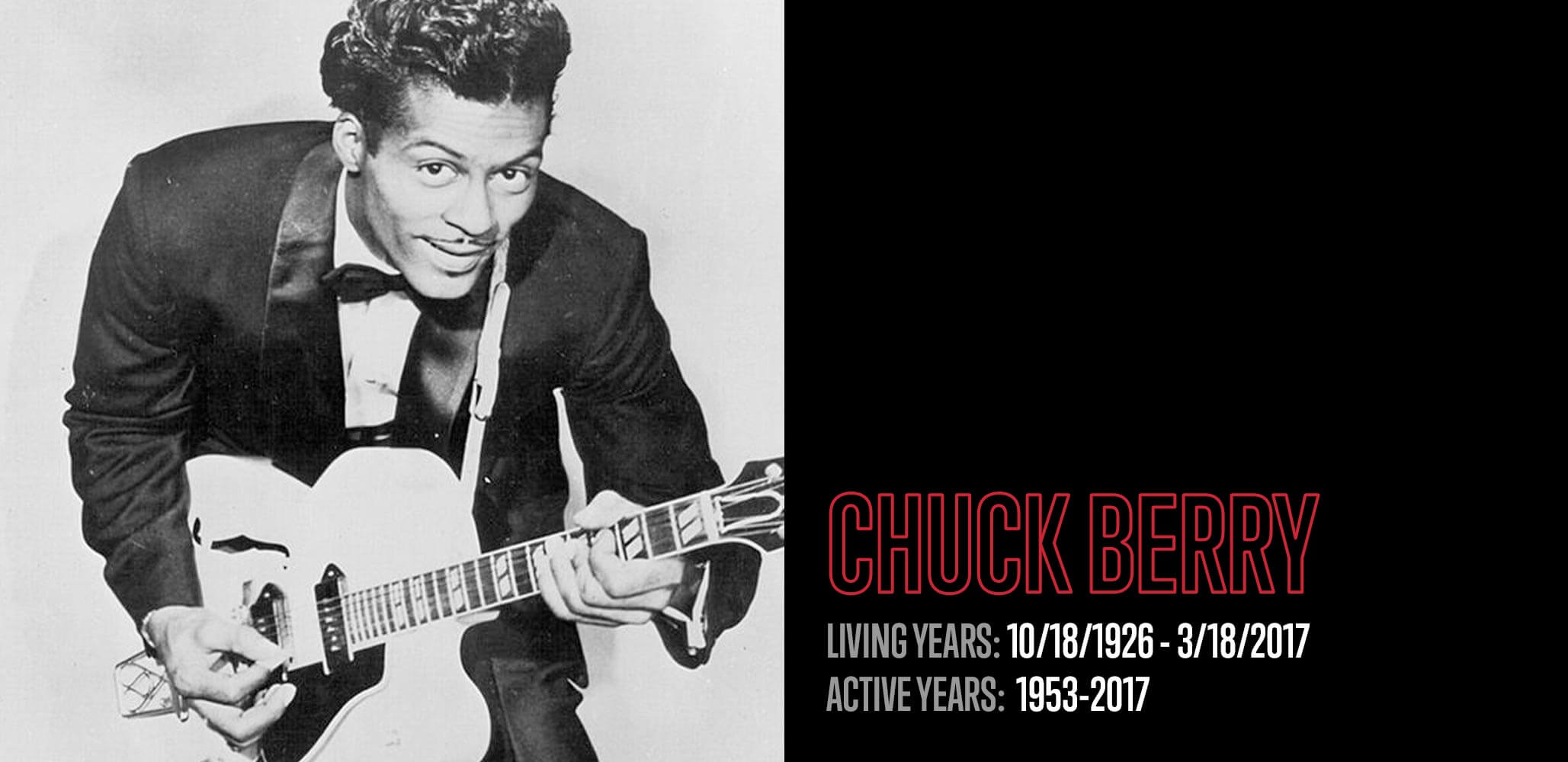
Instruments
Guitar, vocals
Genre
Rock and Roll
Notable Songs
Maybelline, Johnny B Goode, Sweet Little 16, Brown Eyed Handsome Man
Biography
Born to middle class parents in St Louis, Missouri, Charles Edward Anderson Berry started performing in high school. Berry soon had his first of many run-ins with the law and spent several years in a juvenile facility. Chuck began his association with pianist Johnnie Johnson and caught the attention of Chess Records in Chicago, who released his hit single “Maybelline” in 1955. “Maybelline” was essentially a reworking of the Western Swing song “Ida Red”. Chuck was heavily influenced by the showmanship of T-Bone Walker and developed his signature “Duck Walk”. Chuck’s guitar style has been an influence on virtually every guitar player that came after him.
Chuck Berry’s songs painted pictures of an idealized American teenage life: hamburgers sizzling on an open grill, fast cars, and dancing to the jukebox. As one of the forefathers of Rock and Roll, Chuck appealed to both Black and white audiences and was instrumental in bridging them together. During the segregated 50s, he cleverly addressed race in songs such as “Brown Eyed Handsome Man” and “Johnny B Goode” by making the characters relatable to both Black and white listeners.
Inducted into the initial class of the Rock And Roll Hall of Fame in 1986, Chuck continued to play one-nighters across the country using local pick-up bands and was known for insisting on always being paid in cash prior to performing. In 1977, NASA sent gold-plated records into space aboard the Voyager I and II spacecraft; the fact that “Johnny B Goode” was the only contemporary music included is a testament to Chuck’s universal musical relevance. Chuck played a monthly gig in his hometown of St Louis from 1996 to till 2014. He passed away in 2017 at the age of 90. In Chuck’s own words, Hail Hail Rock and Roll!
Technical Innovations
The “Chuck Berry” lick
Historical or Cultural Context
Father of Rock and Roll
Artists/Acts He Influenced
Every guitar player
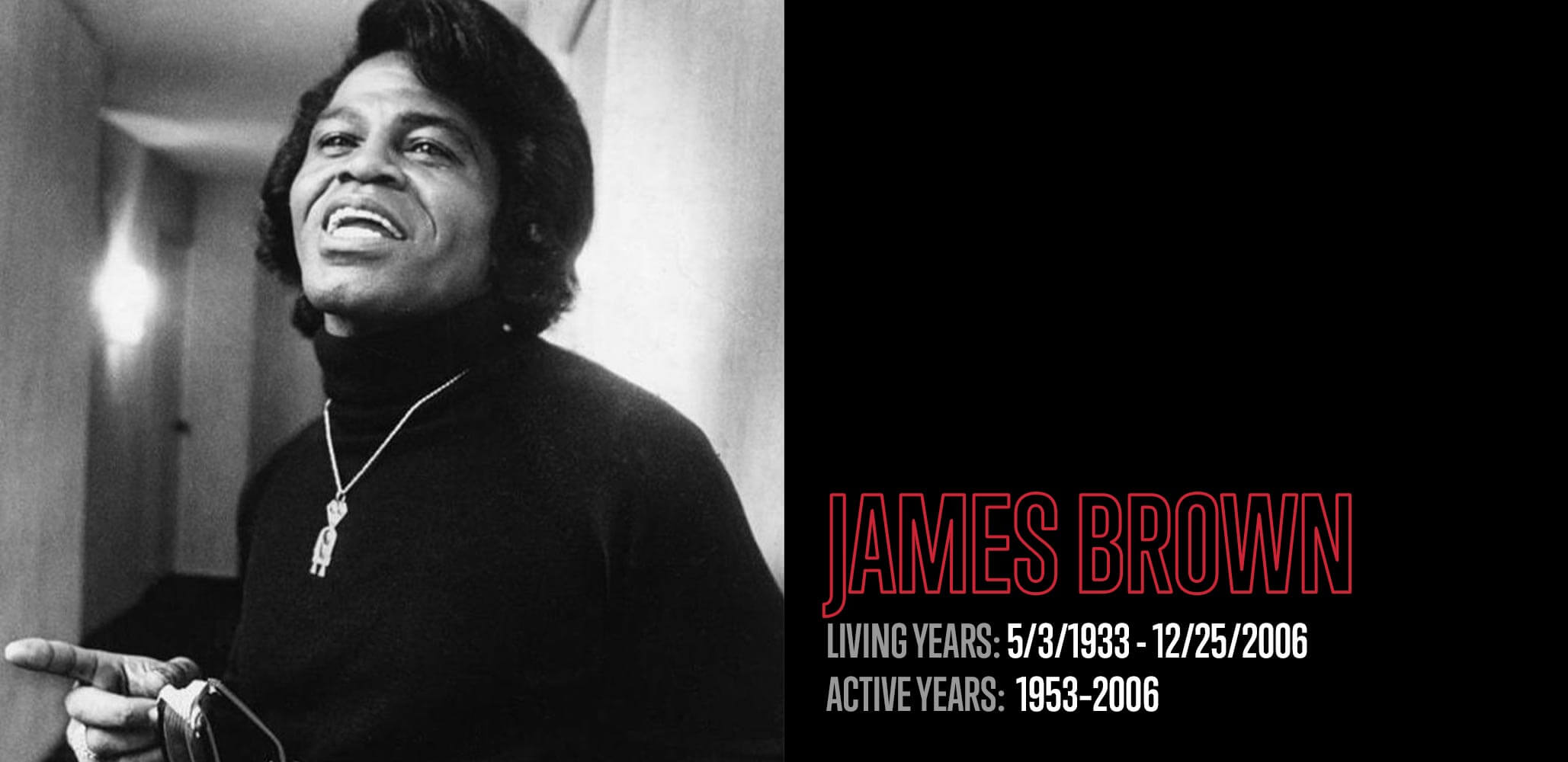
Instrument
Vocals
Genres
Funk, Soul, R&B
Notable Songs
Please, Please, Please, Try Me, Prisoner Of Love, Papa’s Got A Brand New Bag, I Got You (I Feel Good), It's a Man's Man's Man's World, Say It Loud – I'm Black and I'm Proud, Get Up Offa That Thing
Biography
Born in South Carolina, James Brown, known as “The Godfather of Soul,” was known for his creativity and onstage energy, and inspired by Louis Jordan, strove to demonstrate his talent as an expression of freedom.
At the age of 13, Brown sang in his first group, The Cremona Trio, even though music was not his main focus. In 1952 however, he began to pursue music more seriously and started singing with Bobby Byrd in the group Gospel Starlighters (who later became The Avons). Three years later, the group managed to get the attention of Little Richard's manager Clint Brantley. Brantley suggested the band change their name to The Famous Flames and they began performing original material around Macon.
In 1955, their song “Please, Please, Please”, inspired by a napkin on which Little Richard had written those words, caught the attention of producer Ralph Bass who signed them to King Records. They released nine more singles but their anticipated success did not happen. And yet, Brown did not give up.
James Brown put a lot of thought into his stage show during this time and gained a reputation as one of the music world’s most electric performers. He developed a choreographed routine on emotional songs where he would collapse to the ground while singing, causing his bandmates to rush over and help him up. This routine would often include someone draping a cape over him which he would then shrug off as he returned to the mic. It went over huge with crowds!
In the mid-1960s, Brown and the Famous Flames finally got their due with several hit songs including “Papa’s Got A Brand New Bag” and “I Got You (I Feel Good)”. However, tensions within the group and an increasing effort by the record label to promote James Brown above the other members, caused the Famous Flames to split.
Beginning in the late 1960s, Brown began to focus on stripped down musical arrangements and song forms with a heavy emphasis on groove. Songs like “Cold Sweat” and “Funky Drummer” laid the foundation for Funk’s explosion in popularity in the 1970s and Brown, with his new band The JBs, continued to have success with songs like “Get Up (I’m a Sex Machine)” and “The Payback”. In 1968, James Brown’s “Say it Loud - I'm Black and Proud”, released four months after the assassination of Martin Luther King Jr, became an anthem for the Civil Rights and Black Power Movements.
The emergence of Disco, with its lush arrangements and more polished sound, had a negative impact on Brown’s popularity and record sales. He had a career revival in 1986 with the Top Ten hit “Living in America”, which he performed in the movie Rocky IV. The same year, he was inducted into the Rock and Roll Hall of Fame. James Brown received a Lifetime Achievement Award from the Grammys in 1992 and was awarded Kennedy Center Honors in 1993. Although he died in 2006, James Brown remains a huge influence in the music world today and is the most sampled artist in the history of recorded music.
Historical or Cultural Context
Pioneer of Funk, vocal supporter of the civil rights movement
Artists/Acts He Influenced
Mick Jagger, David Bowie, Michael Jackson, Prince, Public Enemy, Funkadelic, The Temptations, Michael Jackson, Bruno Mars, and many others
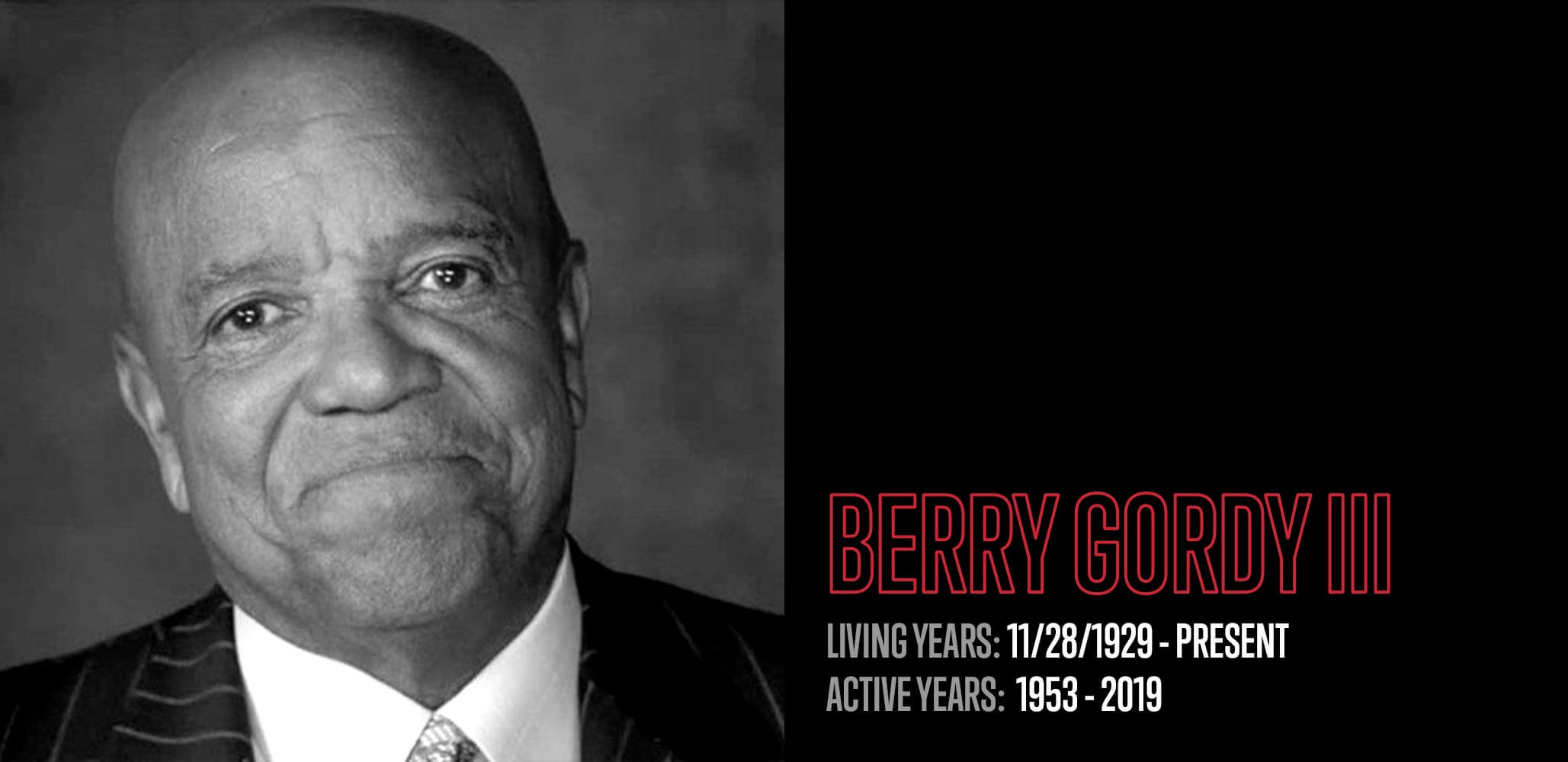
Genres
Soul, R&B, Do Wop
Notable Songs
Associated Artists/Acts
Smokey Robinson and the Miracles, Dianna Ross and the Supremes, The Jackson 5, Temptations, Marvin Gaye, the Four Tops, Stevie Wonder
Biography
Berry Gordy III, also known as Berry Gordy Jr, founded Tamla Records in 1959 which was incorporated into Motown Records in 1960. Motown was the most successful Black owned record label in history with over 180 international #1 songs according to Billboard magazine. In addition to his work as a label executive, producer and songwriter, Gordy is also credited with helping white America accept and embrace Black music and musical artists.
Before going into the record label business, Gordy wrote “Lonely Teardrops” for Jackie Wilson. Tamla/Motown’s first number one hit (and million seller) was “Shop Around” by Smokey Robinson and the Miracles. Gordy co-wrote the tune with Robinson. That was soon followed by the Marvelettes’ “Please Mr. Postman” which was Motown’s first number one on the Billboard Pop Chart.
Motown had a deep roster of artists, songwriters, studio musicians, producers and recording engineers. Motown’s list of artists reads like a who’s who of American Soul: Smokey Robinson, Stevie Wonder, the Jackson Five, Diana Ross and the Supremes, the Four Tops, Marvin Gaye, the Temptations, Mary Wells, Junior Walker, the Marvelettes, and many more. The songwriting team of Holland-Dozier-Holland (Brian and Eddie Holland and Lamont Dozier) wrote dozens of hits for the Supremes, Four Tops, Marvin Gaye and the Temptations. The team of studio musicians collectively known as the Funk Brothers provided “The Sound of Young America”. Motown artists were put through “finishing school” and all of their actions on stage and off were carefully choreographed to present a polished and professional image.
Motown’s early days were an influence on the British Invasion bands, most notably the Beatles who covered Motown hits “Please Mr Postman” and “Money”. Motown acts returned the favor by covering Beatles tunes. Pop music was becoming less segregated with the top English acts sharing the charts with Motown artists side by side. Motown also provided powerful social commentary with Marvin’s Gaye’s “What’s Going On” and “War” by Edwin Starr.
Gordy sold his interest in Motown in 1988 and officially retired at the age of 89 in 2019. There are few people who have had such a significant and wide ranging impact on popular music. Gordy was inducted into the Rock and Roll Hall of Fame in 1988. In 2016, President Barack Obama awarded Gordy the National Medal of Arts for his contributions to American music and culture.
Technical Innovations
In-house songwriting, production and talent
Historical or Cultural Context
One of the most successful Black business owners ever
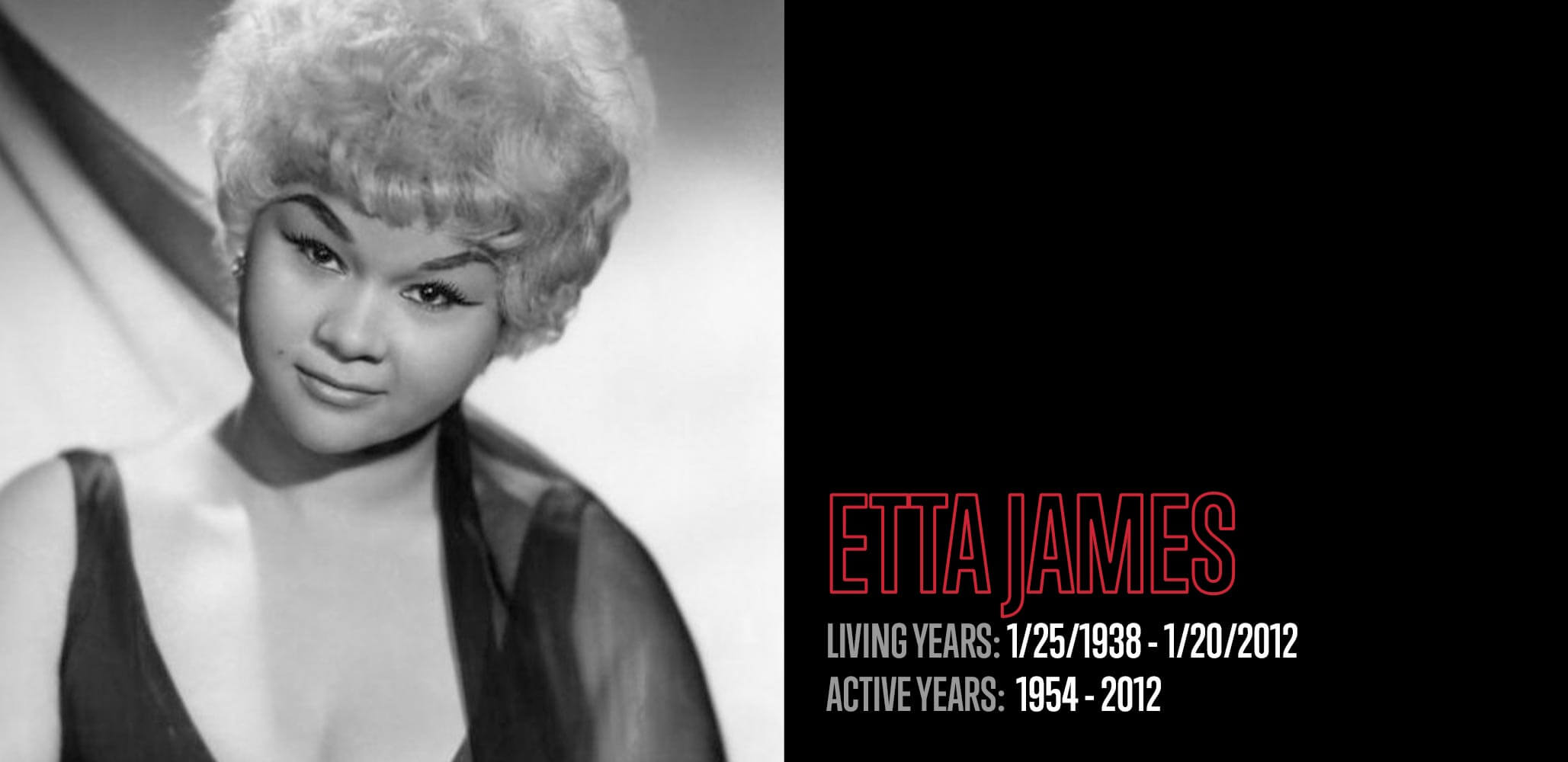
Instrument
Vocals
Genres
Blues, R&B, Soul, Gospel, Jazz, Rock and Roll
Notable Songs
At Last, Tell Momma, Something’s Got a Hold On Me
Associated Artists/Acts
Harvey Fuqua, Johnny Otis, Sugar Pie DeSanto, Clarence Carter, Bobby Murray
Biography
Etta James was a powerhouse vocalist whose style traversed many genres, including Blues, R&B, Soul, Rock and Jazz. While not fully appreciated in her prime, James has since been recognized as one of the most influential singers in American music history, especially for the way she blended the edginess of Blues and Rock with the smoother R&B and Jazz tradition.
James had some minor success in various “girl groups” in her teens before signing with Chess Records in 1960, where she quickly established herself with her well-known version of “At Last”. James continued to find success with a string of hits throughout the 1960s, including the gospel-tinged “Something’s Got a Hold on Me” and the raucous “Tell Mama”. Her style continued to evolve further into rock and funk in the 1970s. After a hiatus in the 1980s, James had a “comeback” in the 1990s, winning multiple Grammy awards including one for the album Mystery Lady, her tribute to the music of Billie Holiday.
Beyond being a dynamic vocalist and performer, renowned for her alto range and gritty delivery, Etta James was also a successful songwriter, writing many of her own songs as well as hits for other artists. She influenced some of Rock music’s most well-known singers. Janis Joplin was a huge admirer and covered “Tell Mama” in concert. James was inducted into the Rock and Roll Hall of Fame in 1993.
Historical or Cultural Context
Pioneer of early R&B and Rock and Roll
Artists/Acts She Influenced
Tina Turner, Diana Ross, Janis Joplin, Christina Aguilera, Adele, Beyoncé, Joss Stone
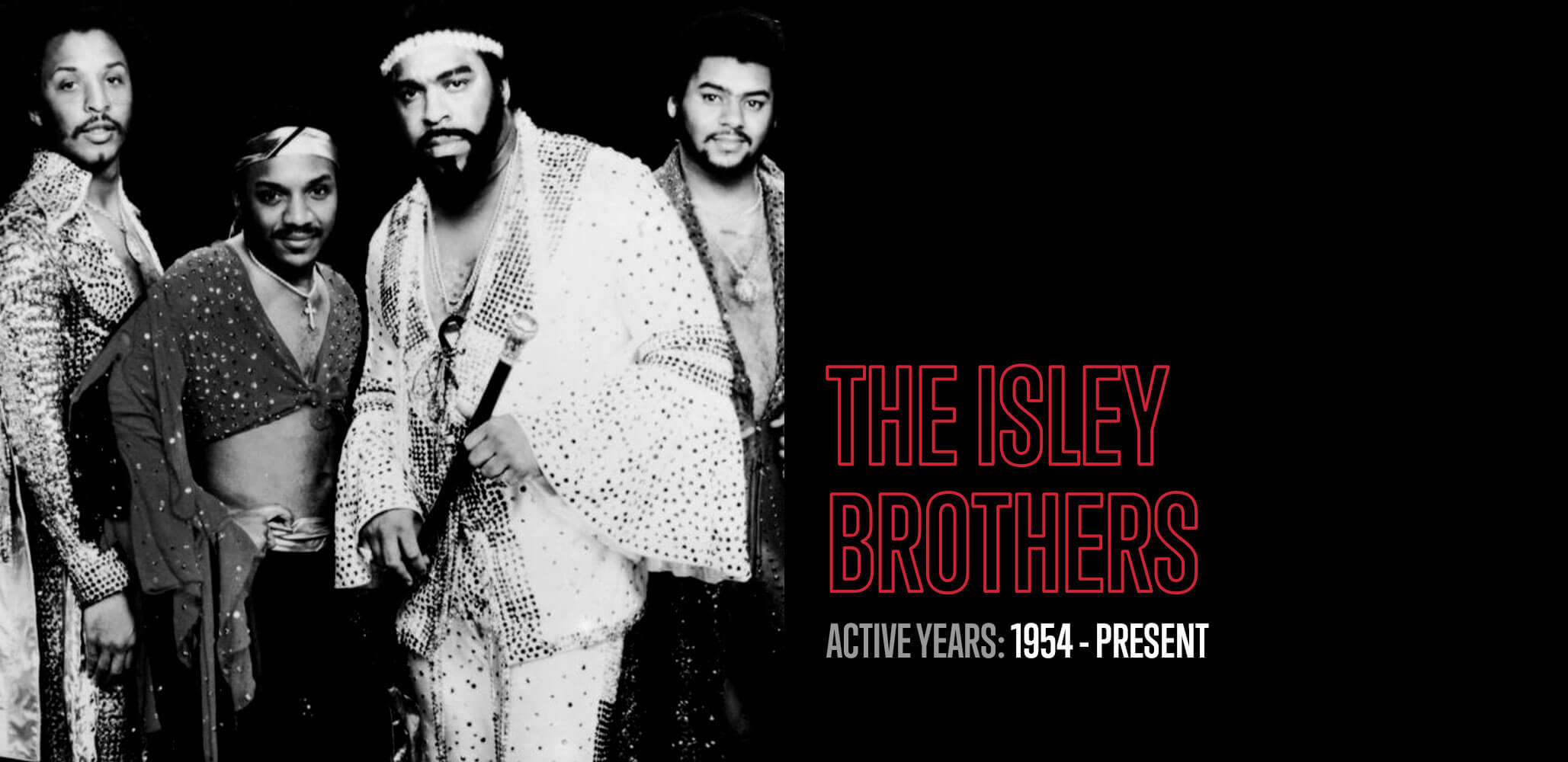
Instruments
Vocals, guitar, bass, keys
Genres
Soul, R&B, Funk, Rock
Notable Songs
Shout, Twist and Shout, It’s Your Thing, Who’s That Lady
Associated Artists/Acts
Jimi Hendrix, the Beatles, Otis Day and the Knights
Biography
The Isley Brothers began performing as a Gospel quartet in Cincinnati, OH, in the early 50’s. After the untimely death of Vernon Isley, the other three brothers, O’Kelly Isley Jr., Rudolph Isley and Ronald Isley, set their sights on moving to New York City to pursue popular music. In 1959, they wrote and recorded the Gospel inspired “Shout” which became a million seller and an instant classic.
More success quickly followed with the 1962 release of “Twist and Shout”, which was covered by the Beatles just a year later. In 1964, the brothers formed their own record label, T-Neck, and hired a young upstart guitar player named Jimi Hendrix. Their single “Testify” features Hendrix’s guitar wailing alongside an absolutely frantic vocal performance by Ronald Isley.
The band signed to Motown, recording on the Tamla imprint. They had a minor hit in 1966 with “This Old Heart of Mine” but felt overlooked by label head Berry Gordy. The band left Motown, resurrected their T-Neck label, and scored the biggest hit of their career with 1969’s “It’s Your Thing”. The song marked a departure from the Gospel vocal group style the Isleys were known for, instead opting for more of a Funk sound. Younger brother Ernie Isley contributed bass to the song. In 1971 the vocal trio officially expanded to a full six-piece band as Ernie switched over to guitar, brother Marvin Isley took over bass duties and brother-in-law Chris Jasper was added on keys.
The band’s new sound incorporated more elements of Rock and Funk with Ernie Isley adding a Hendrix vibe with his lead guitar. They continued to release successful albums including 1975’s The Heat Is On, which featured “Fight the Power”. “Fight the Power” was the inspiration for Public Enemy’s anthem of the same name, featured in Spike Lee’s 1989 film Do The Right Thing. 1983’s album Between the Sheets was a minor hit and Biggie Smalls used the title track as the foundation of Big Poppa, further cementing the bond between the Isley Brothers and the Hip Hop world.
Between the Sheets was the last album to feature all of the brothers and Jasper. Since then, different configurations of the members have released various recordings. Kelley Isley passed away in 1986 and Rudy retired from performing in the 90s. For their contributions to Rock and Roll, the Isley Brothers were inducted into the Rock and Roll Hall of Fame in 1992. Ron and Ernie Isley continue to perform, keeping the Isley Brothers’ legacy alive.
Historical or Cultural Context
Went from Gospel-inspired vocal group to Soul/Funk/Rock
Artists/Acts They Influenced
Beatles, Public Enemy, Notorious B.I.G.
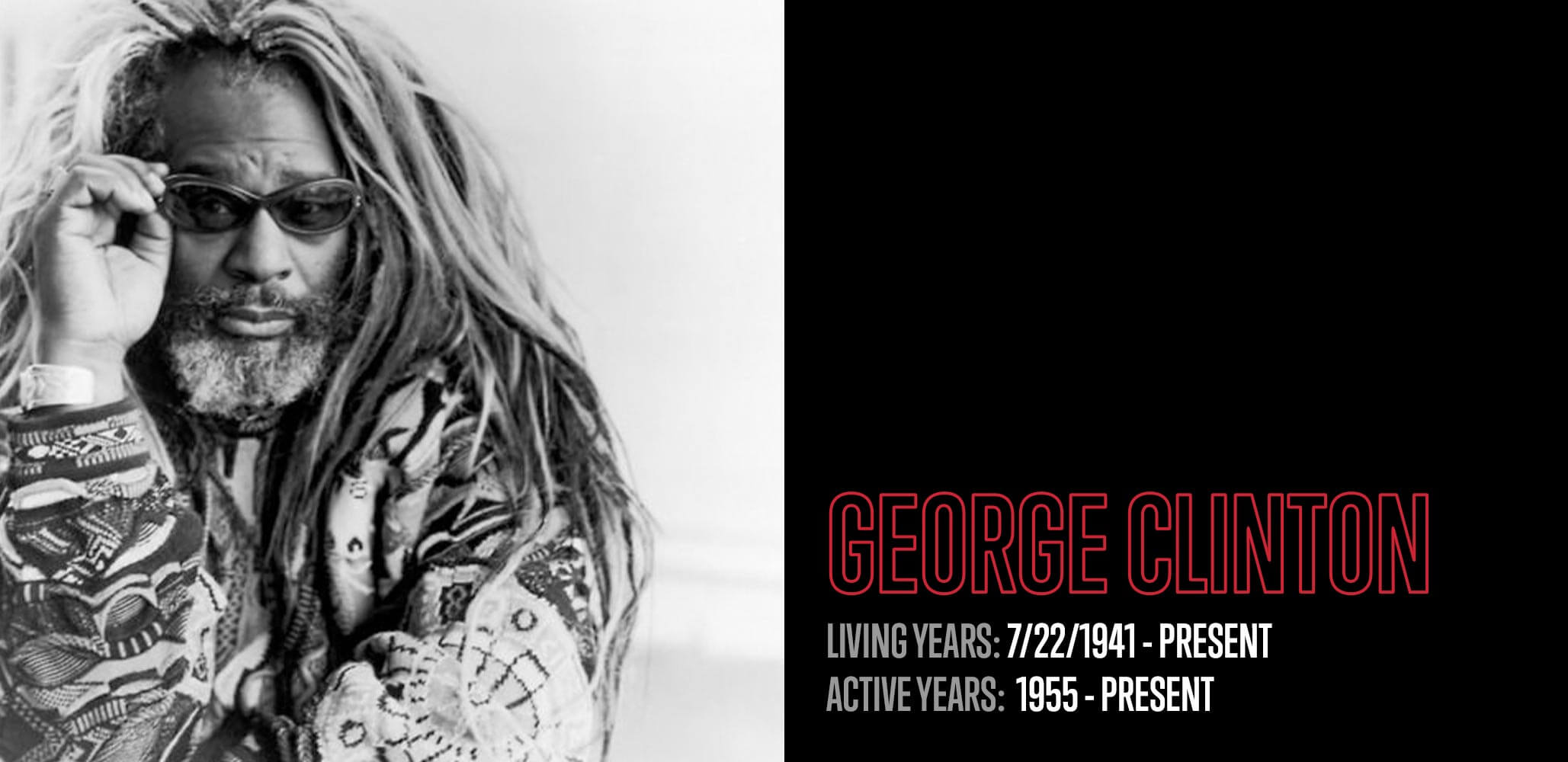
Instrument
Vocals
Genre
Funk
Notable Songs
Flash Light, (I Wanna) Testify, Give Up the Funk (Tear the Roof Off the Sucker), One Nation Under a Groove
Associated Artists/Acts
Funkadelic, Parliament, Bootsy Collins, P-Funk All Stars, Bootsy’s Rubber Band
Biography
George Clinton grew up in Plainfield, New Jersey, where as a teen in the 1950s he was inspired by Doo Wop music and started his first group, The Parliaments. The group had a hit with “(I Wanna) Testify” and Clinton briefly worked as a songwriter and producer at Motown before evolving The Parliaments into the groups he is most famously associated with: Parliament and Funkadelic.
By the late 1960s, Clinton and his bandmates had become increasingly influenced by the emerging Soul and Funk genres and set out to combine these elements into something totally new, a creative collective that blended Funk, Soul, humor, dance, costumes, science fiction and a rocking stage show. Because of legal issues with the name “The Parliaments”, the band first reformed under the Funkadelic name. Soon, Funkadelic and Parliament were two separate contemporaneous bands signed to two different labels, but featuring mostly the same large musical ensemble! Funkadelic tended towards edgier, Rock-based Funk, while Parliament leaned towards smoother R&B styles of Funk. Eventually, these two groups became known informally as P-Funk. Guided by Clinton’s songwriting, artistic vision, leadership and audio production, P-Funk was responsible for numerous successful singles and albums in the 1970s, especially Maggot Brain (Funkadelic) and The Mothership Connection (Parliament), which are widely considered to be landmark albums in the evolution of the Funk genre.
Through band lineup and record label changes in the 1980s and 1990s, Clinton continued to release albums either under his own name or as The P-Funk All Stars. He also began branching out as a producer and songwriter, working with artists such as Ice Cube, Red Hot Chili Peppers, Tupac Shakur and his former bandmate Bootsy Collins.
George Clinton’s legacy is unquestioned as one of the big pioneers of Funk music along with James Brown and Sly Stone. His creativity and vision of music performance as a visual as well as aural experience was a significant influence on artists like Prince. Clinton’s influence has continued to seep into contemporary music as he is one of the most sampled artists of all time. He retired from touring in 2019, but has urged P-Funk to continue on without him. Clinton and 15 other members of the Parliament-Funkadelic collective were inducted into the Rock and Roll Hall of Fame in 1997.
Historical or Cultural Context
Funk pioneer, visionary bandleader
Artists/Acts He Influenced
Prince, Red Hot Chili Peppers, Dr. Dre, Tupac Shakur, OutKast, Galactic
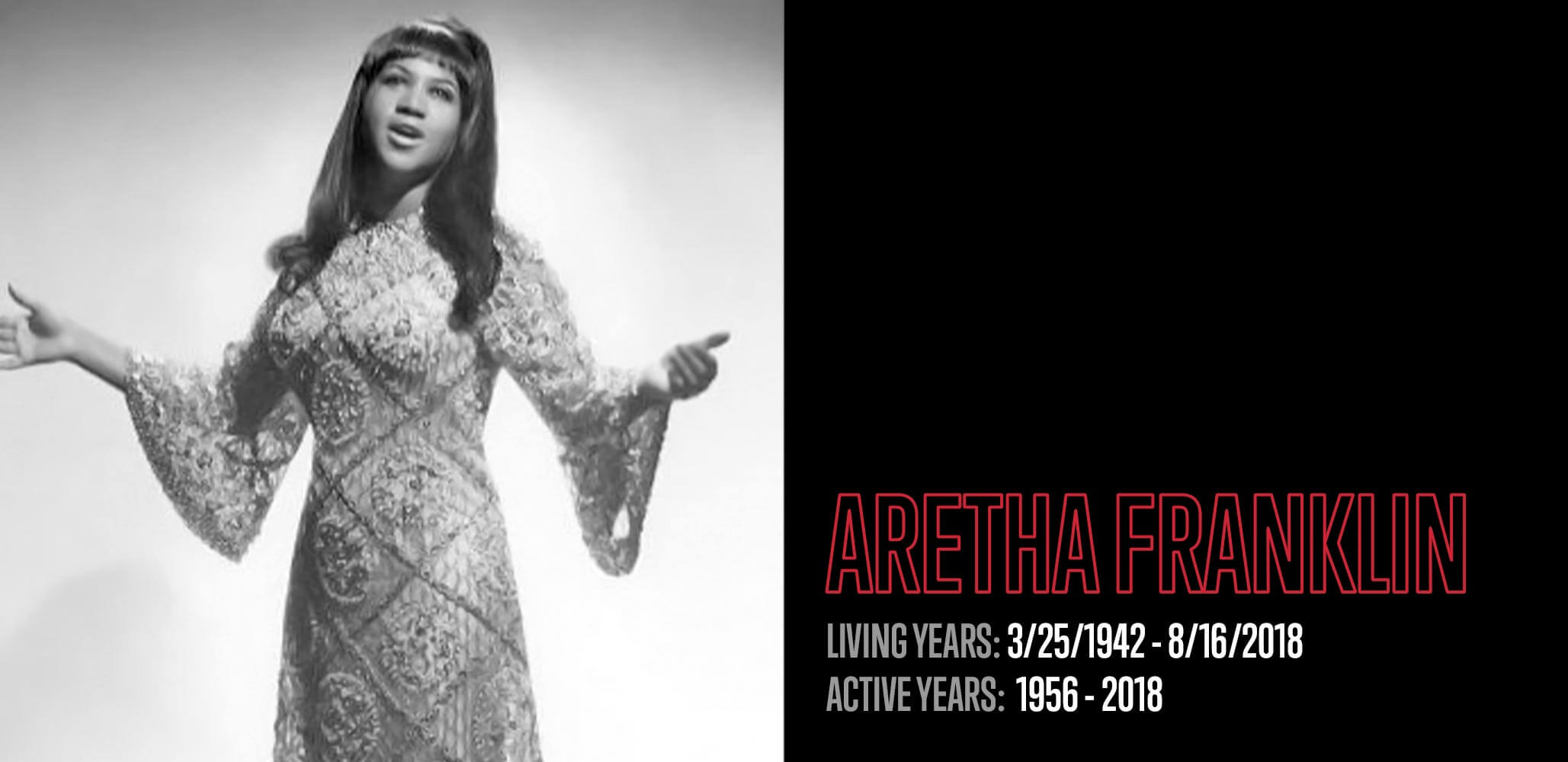
Instruments
Vocalist, piano, organ
Genres
Blues, Gospel, R&B, Jazz, Rock
Notable Songs
Respect, Think, (You Make Me Feel Like) A Natural Woman, Amazing Grace, Chain of Fools, Bridge Over Troubled Water
Biography
Known as the “Queen of Soul,” Aretha Louise Franklin was born in Memphis, Tennessee, and raised in Detroit, Michigan. Her father was a well-known Baptist preacher and her mother was a gospel singer. Aretha grew up singing gospel music with her sisters. Aretha’s father’s popularity led to many celebrities visiting them. Musicians and religious leaders such as Clara Ward, James Cleveland, Albertina Walker, Martin Luther King Jr., Jackie Wilson and Sam Cooke all were close to the family.
The tragedies she experienced throughout her life were reflected in her music. Aretha sang from her heart. Aretha had many influences on her music. She was heavily influenced by Clara Ward and Mahalia Jackson, who cared for her after her mother’s death when she was 10 years old. She also admired the up and coming Motown artists; Doo Wop artists such as The Platters, The Drifters, The Clovers, Frankie Lymon, Jackie Wilson, Ruth Brown, Little Richard, Church Berry, Fats Domino, BB King and others. In turn, her career influenced countless artists.
“Aretha influenced everybody… Rock and Roll, Soul, Jazz. There were so many lessons to be learned from Aretha: In rhythm, in control, in how and when to embellish the melody and, even more importantly, when not to. And in life: She stood up.” - Benmont Tench, keyboardist for Tom Petty & The Heartbreakers
Some of her soulful hits like “Respect” served as a template for contemporary Rock and Roll artists who recorded out of the Muscle Shoals recording studio in the 60s and beyond. The powerful messages in her songs subliminally set the standard for Rock and Roll music.
Aretha got her start singing Gospel music but managed to also express Black musical traditions by blending Jazz, R&B and Blues. And somehow Gospel always found its way back into her music.
The Soul Queen “took you to church even if she was singing about a no-good man,” - Candi Staton, singer.
Aretha passed away in her home in Detroit in 2018 at the age of 76.
Aretha has been honored with many awards in recognition of her incredible career. She was the first woman inducted into the Rock and Roll Hall of Fame in 1987. She won an incredible 18 Grammy awards throughout her career including a Grammy Legend Award in 1991 and a Grammy Lifetime Achievement award in 1994. She was also awarded the Presidential Medal of Freedom in 2005.
Technical Innovations
During her time with Columbia Records (1960-65) Aretha was introduced to new recording technology, multi-tracking, that allowed her to personally sing and play several parts of the song.
Historical or Cultural Context
Queen of Soul
Artists/Acts She Influenced
Beyoncé, Jennifer Hudson, Adele, Dolly Parton, Tammy Wynette, and countless others
This article was last updated in September, 2020.




